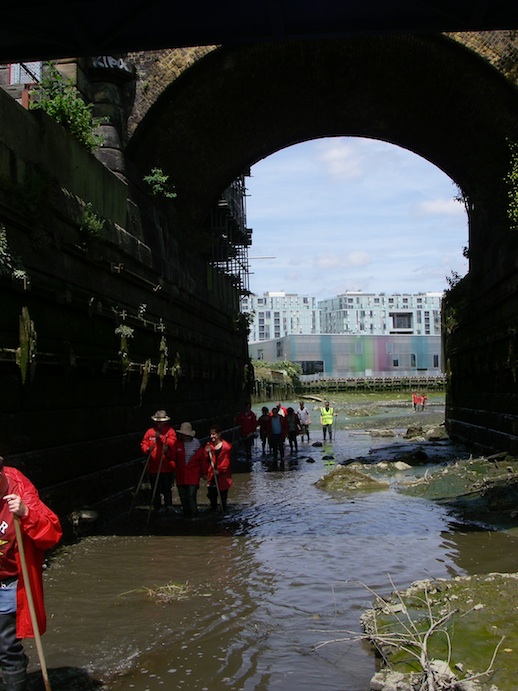Emma Warren explores a tidal creek in South-East London:
The Creekside Centre in Deptford sits next to an industrial centre, off a brutal main road that links Greenwich to the Rotherhithe Tunnel. Inside, a tiny corridor is lined with shelves. This is the Centre’s collection of specialist detritus brought up from the Ravensbourne: ancient mobile phones, driving licences, bones, cans, a pair of Javan faces smoothed out from a broken statue. It looks like a conservationist’s version of the Mutoid Waste Company peopled not by dystopian desert punks but by folk in muddy red coats and waders, holding the big sticks that will keep them upright during the imminent low tide walk.
Nick Bertrand is a conservationist with a seafaring laugh. He hoists himself onto the edge of a raised bed of wild flowers and gathers us round. What starts as a piece of incidental context – pointing out the Rue-leaved saxifrage behind him – turns into a intriguing sermon on planting and self-seeding and the commodification of the wild. Corn Camomile bought in your average garden centre, he says, is actually Austrian Camomile, what botanists now call a ‘lookalike species’. “You’re being conned left right and centre,” he says, thrillingly, tossing facts about wildflowers inability to thrive away from their home like so many poppy seeds in the air. The flowers here at the Centre were translocated from a few miles away, which was lucky, he says, because the original site has been destroyed. Wild, it seems, is actually another way of saying ‘local’.
I’m here with my friend Kate Ling who wrote about this south London waterway in her award-winning poem Deptford Creek and we start the short walk to the river one in front of the other. This small incline, maybe a hundred meters, is a liminal zone. We’re already somewhere else – stepping out of normal life towards the water, dropping learned adult personas and adopting something receptive and natural. Land becomes specific: the slanted strip to our left comprises three distinct areas of marsh which changes by degrees before the transition into mudflat and water. These are distinct zones, with different needs and different communities. At the top, there’s round-headed Nordic native Angelica, drifting down in the middle marsh, there’s highly lethal Hemlock Water Dropwort. So far, so exotic.
The creek is located at the tidal reach of the Ravensbourne, which meets our other local waterway, the Quaggy, behind Lewisham bus station before flowing into and out of the Thames. There’s the roller coaster rumble of the DLR above our heads, and we walk upstream towards a man-made bend. There are high bare walls and mud flats on either side of the slow green flow. We are in the deep ford that gave Deptford it’s name, a place that has been colonised by people since at least the 11th Century when the Domesday book notes eleven corn mills on the river, and where the original Golden Hind rested until it rotted and broke up.
I learn a new word: ‘syzygy’, which describes the lunar configuration of earth, sun and moon lining up at full moon and no moon, and how the tides bring a new layer of mud into the creek twice a day which accumulates until the next heavy rainfall when it’s flushed back out of the creek into the Thames.
It feels good in the creek. I feel like I’m rowing the boat of myself, navigating through the water with the momentum of my big stick. Sadly I am a boat with a leak as one of my waders has a slow puncture and gradually I experience a tidal increase of water up my leg. When I eventually return and take my waders off I have a high tide mark, mid calf, where Ravensbourne dregs met not the exterior of rubber, but skin.
The creatures of the creek are all around us. Like the Asian Clam. It’s an invasive species that was first found eight years ago in Richmond, and is now everywhere. Experts have no idea what impact they’ll have. Then there are two swans, lurking in the stairwell of the creek bend. In the altered narrative of the low tide walk, the swans have become lemon-faced geezers outside a dodgy pub. They are to be respected and avoided. We purposefully avoid eye contact and pretend they’re not there.
Nick reaches underneath a brick and picks up two leeches. They are terrible, inky punctuation marks that wriggle across and in-between his fingers. They are a black silky comma followed by a fat slash of the pen and I find myself wriggling backwards through the crowd when they’re shoved towards me. I do not like leeches, even if they do look as if they’ve come straight out of a Studio Ghibli film.
Safer are the Chinese Mitten crabs who live under a bit of chucked-away carpet. The crab is green, but that’s because it’s actually just a shell. Crab moved out when space got tight. Nick opens up the flip-top mechanism of the shell, and it really does open like a hinged box. Then we find two big ones under a metal sheet. One gets away and the other is held above the water, arms and legs dancing in air until he’s gently returned to the rusting comfort of home.
And that’s the thing. Rubbish is good for the river. When the Creekside Centre opened in 1999 they removed over 400 shopping trolleys from the creek and fish stocks decreased by 50%. Our discarded debris replaces the natural habitats that used to hog the sides of the creek, like reed beds. The trolleys are particularly good, because their metal grids become clogged with other bits of rubbish, which provide excellent hiding places for small creatures. We clear the river for people, Nick says, because of their perception of how the river should look.
A deep ford, in more ways than one.
